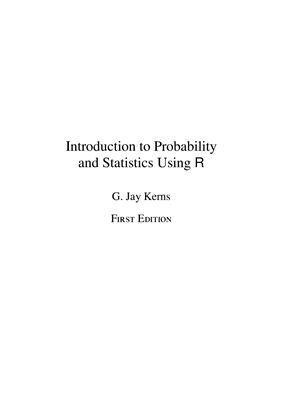G. Jay Kes, 2010. - 386 pages.
This book was expanded from lecture materials I use in a one semester upper-division undergraduate course entitled Probability and Statistics at Youngstown State University. Those lecture materials, in tu, were based on notes that I transcribed as a graduate student at Bowling
Green State University. The course for which the materials were written is 50-50 Probability
and Statistics, and the attendees include mathematics, engineering, and computer science
majors (among others). The catalog prerequisites for the course are a full year of calculus.
The book can be subdivided into three basic parts. The first part includes the introductions
and elementary descriptive statistics; I want the students to be knee-deep in data right out of
the gate. The second part is the study of probability, which begins at the basics of sets and
the equally likely model, joueys past discrete/continuous random variables, and continues
through to multivariate distributions. The chapter on sampling distributions paves the way to
the third part, which is inferential statistics. This last part includes point and interval estimation,
hypothesis testing, and finishes with introductions to selected topics in applied statistics.
This book was expanded from lecture materials I use in a one semester upper-division undergraduate course entitled Probability and Statistics at Youngstown State University. Those lecture materials, in tu, were based on notes that I transcribed as a graduate student at Bowling
Green State University. The course for which the materials were written is 50-50 Probability
and Statistics, and the attendees include mathematics, engineering, and computer science
majors (among others). The catalog prerequisites for the course are a full year of calculus.
The book can be subdivided into three basic parts. The first part includes the introductions
and elementary descriptive statistics; I want the students to be knee-deep in data right out of
the gate. The second part is the study of probability, which begins at the basics of sets and
the equally likely model, joueys past discrete/continuous random variables, and continues
through to multivariate distributions. The chapter on sampling distributions paves the way to
the third part, which is inferential statistics. This last part includes point and interval estimation,
hypothesis testing, and finishes with introductions to selected topics in applied statistics.

